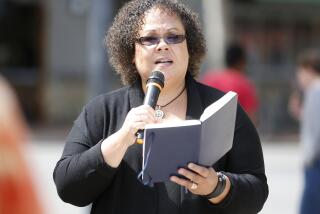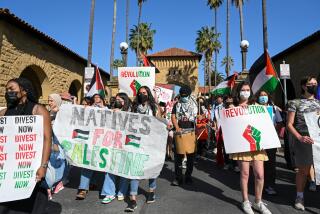Stanford’s J. Wallace Sterling Dies : Widely Honored Educator Headed University for 19 Years
John Ewart Wallace Sterling, the widely honored educator who served as president of Stanford University for almost 20 years, died Monday night at his home in Woodside after a lengthy battle with cancer, the university announced Tuesday. He was 78.
A member during his lifetime of dozens of academic and public service committees, the boards of directors of four major corporations and five of California’s most prestigious clubs, Sterling was the recipient of numerous major awards, including the Order of Merit of the Federal Republic of Germany, the Legion d’Honneur of France and the Order of the British Empire.
The man who preferred to be called Wallace or “Wally” was named president of Stanford in 1949--when classes were still crowded with veterans of World War II. He held the post until 1968, long enough to administer the education of the sons and daughters of those veterans.
Under his guidance, Stanford both grew bigger and stayed small. The graduate program was vastly upgraded, and Stanford became the first major U.S. university to establish branches overseas. But the enrollment remained relatively diminutive, by major university standards--11,500, almost half of them graduate students.
List of Achievements
“The job of a university president is to take all the blame and share all the credit,” Sterling once said. During his tenure, the university’s accomplishments were many, and the ledger weighed heavily on the side of credit:
- The faculty grew four times as fast as the student body, giving the school one of the best teacher-student ratios in the country, adding such eminent educators as historian David Potter, mathematician Edward Begel and novelist-critic Albert Guerard.
- The graduate programs, ranked 13th in the nation in 1957, had moved up to third place by the time he retired in September, 1968.
- Five undergraduate campuses were established in Europe, and seven graduate centers were opened around the world.
- Gifts and bequests to the university totaled nearly $330 million, 10 times the amount raised in the 40 years before Sterling, once described as “Stanford’s man with the Midas touch,” became president.
- The value of the physical plant in Palo Alto rose from $22 million to $145 million.
Sterling, a man who valued the tranquillity of an academic environment, managed to escape most of the campus turmoil of the 1960s. But in the end, just before he retired, it caught up with him.
On May 6, 1968, about 200 student demonstrators occupied the Old Student Union Building on the Palo Alto campus, vowing to remain until their demands were met. Among those demands: that Sterling reject the recommendations of a faculty committee that seven students be suspended for leading a campus demonstration against representatives of the Central Intelligence Agency.
After 57 hours, a divided faculty knuckled under, setting aside the proposed suspensions and recommending reforms in campus rules that would give students a greater voice in disciplinary actions against their peers.
The next day, Sterling accepted the recommendations, despite “serious misgivings about the wisdom of some of them.” He had little choice. To reject the recommendations would have repudiated one of the most distinguished faculties in the world--one that he had helped to build. And he knew that refusal to accept the faculty’s vote could have led to the sort of chaos that had enveloped the nearby UC Berkeley campus a few years earlier.
Sterling never argued the right of students to participate in direct political action, but he reminded them that they did so on their own.
Office Break-In
“Students who use some of their time to demonstrate, sit in or otherwise engage in direct action are doing so as citizens,” he told a Stanford convocation three years before the Student Union building sit-in. “There is nothing academic about such experiences.”
Two months after the sit-in, Sterling suffered another blow. Someone broke into his office, sprinkled gasoline on his desk and set the room ablaze. Before firemen could extinguish the fire, treasured books, notes, manuscripts and the memorablia of a 30-year career were in ashes.
“It was the fate of the times,” he told an interviewer later. “I don’t think there was anything personal in it.”
Born in Ontario, Canada, on Aug. 6, 1906, Sterling earned his bachelor of arts at the University of Toronto, where he played both football and basketball. While getting his master’s degree at the University of Alberta, he coached Calgary’s municipal football team.
Nightly News Broadcast
After completing his doctorate in history at Stanford, Sterling moved to Caltech, advancing from assistant professor of history in 1937 to chairman of the department from 1944 to 1946. While at Caltech, he did a nightly broadcast on CBS radio in Los Angeles as a news commentator.
In 1947, the year he became a U.S. citizen, Sterling served on the resident civilian faculty of the National War College in Washington.
Two years later, after a stint as director of the Huntington Library and Art Gallery in San Marino, he was named president of Stanford.
Honorary degrees followed--21 in all--ranging from local schools such as Pomona and Occidental colleges to eastern schools--Columbia and Harvard universities--and schools overseas--Durham University in England and the University of Caen in France.
Board Directorships
He served in the Assn. of American Universities, the Office of Naval Research Advisory Board, the U.S. Advisory Committee on Educational Exchange, the Ford International Fellowship Board and the State Department’s Advisory Committee on Foreign Relations. Board directorships included Kaiser Aluminum & Chemical Corp., Shell Oil Co., Tridair Industries and Dean Witter & Co. Club affiliations included the Commonwealth, Bohemian and Pacific-Union clubs in Northern California and the California and Sunset clubs in the Los Angeles area.
After retiring as Stanford’s president, he assumed a lifetime appointment as chancellor of the university, a largely honorific post.
He leaves his wife of 54 years, Ann Marie; a son, William Wallace Sterling, and two daughters, Susan Sterling Monjauze and Judith Sterling Morse.
Memorial services are scheduled at 11 a.m. Tuesday in Stanford Memorial Church at Stanford. In lieu of flowers, donations are requested to Stanford University, 301 Encina Hall, Stanford, 94305, or Fioli Center, a historic estate located on Canada Road in Woodside, 94062.
More to Read
Sign up for Essential California
The most important California stories and recommendations in your inbox every morning.
You may occasionally receive promotional content from the Los Angeles Times.









